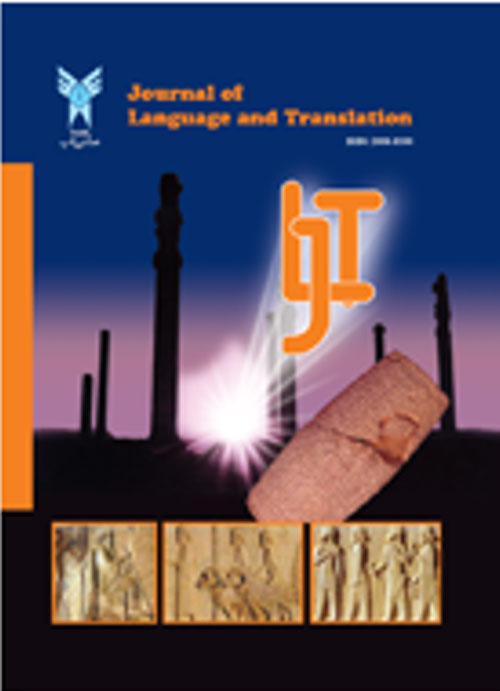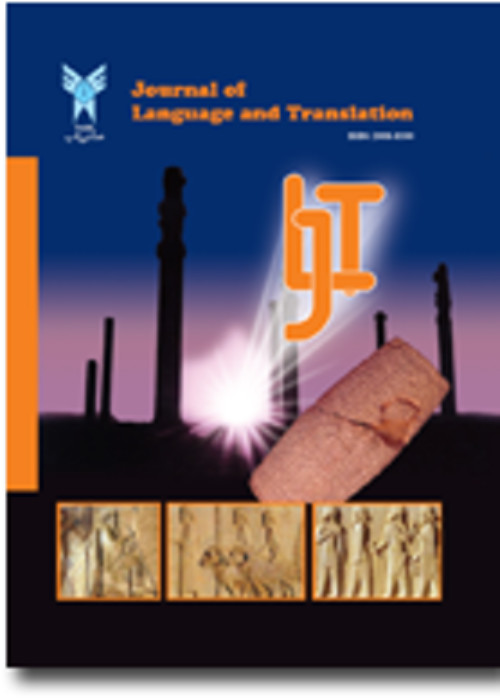فهرست مطالب

Journal of Language and Translation
Volume:5 Issue: 1, Summer 2015
- تاریخ انتشار: 1394/03/25
- تعداد عناوین: 8
-
Pages 1-16The present study investigates the relationship between multiple intelligences and teaching styles of Eng-lish as Foreign Language (EFL) learners and teachers. The participants of the study included 106 EFL teachers and 400 EFL learners. Teachers were invited to complete a Multiple Intelligences Inventory for EFL Teachers, developed by Christison (1998) and a Thinking Styles Inventory in Teaching, developed by Grigorenko and Sternberg (1993). The students were also asked to complete Student-Generated Inven-tory for Secondary Level and Young Adult Learners, which was developed by Christison (1996; 1998). The results of the descriptive statistics showed that EFL teachers and students preferred the interaction of different kinds of multiple intelligences and teaching styles in the classroom. Pearson correlation, three-way ANOVA and Multivariate ANOVA further illustrated that there was a significant relationship be-tween EFL teachers multiple intelligences and the styles of teaching. Factors such as age, field of study and gender, however, did not have any significant effect on multiple intelligences and teaching styles of EFL teachers.Keywords: The theory of multiple intelligences, teaching styles, cognitive psychology, English as for, eign language (EFL) teachers, learners, cognitive development
-
Pages 17-31Autonomy is the ability to take charge of ones own learning. However, this ability is not inborn and must be acquired by formal instruction (Holec, 1981). Therefore, to offer a systematic approach to the devel-opment of learner autonomy in language learning process, Benson (2001) argues that learner autonomy is described in terms of learners control over the three dimensions of learning management, cognitive pro-cesses, and learning content. However, developing learner autonomy through systematic instruction has received little attention in EFL context. To bridge this gap, this study aims to provide experimental sup-port for the impact of applying Bensons (2001) three-level model of learner autonomy on fostering au-tonomy among EFL learners. To this aim, the data were collected and analyzed from a group (N=40) of English as a foreign language learners, doing their bachelors degree. The results indicated that autonomy subscale was greater after the completion of instructional intervention. Besides, further investigation pro-vided evidence on the fact that autonomy is not an all-or-nothing concept as the learners reached "inter-vention level" of degrees to learner autonomy. In total, this study suggests that each dimension of auton-omy in language learning should be developed separately, although many researchers often attach more importance to one level of control than others.Keywords: Autonomy, attention, cognitive processes, learning management, Metacognitive Strategy, Reflection
-
Pages 33-41Critical Discourse Analysis as an interdisciplinary approach aims at making transparent the connections between discourse practices and social practices and provides ways of looking into translations from a critical standpoint.Farahzad is among the scholars who presented her specific CDA model inspired by Faircloughs approach. The present Critical Discourse Analysis (CDA)-based study aimed to explore the probable ideological manipulations exerted in the three translations of a single English political book called "Media Control" by "Noam Chomsky." This comparative qualitative study was conducted based on Farahzads (2011) three-dimensional CDA model. The textual, paratextual, and semiotic as-pects were critically scrutinized. At textual level, it was revealed that different manipulative strategies, mostly addition, deletion, and deliberate lexical selection were applied by the translators to incorporate their own ideologiesand stances.At paratextual level, the existence of extended footnoteswasobserved, and at semiotic level, the book covers designs and colour combinations which were the indicators of the translators lines of thoughts and ideologies were analyzed.Keywords: critical discourse analysis (CDA), Discourse, ideology, manipulation, Translation Criticism
-
Pages 43-52The present study addresses the influence of Irans post-Revolution political structure on the formation of the countrys translated literature system. It examines the translated Anglo-American novels pub-lished under two administrations in power after the Islamic Revolution: 1) the Reformist administra-tion, which was a more liberal, leftist administration, seeking to improve Irans relations with the West and promising to give people more social freedoms and to open the political atmosphere of the country, 2) the Fundamentalist administration, a conservative administration with hostile, aggressive policies towards the West, which maximized Iran and Wests confrontations in the international arena. The ma-nipulations found in the novels published under each administration were compared to see what manip-ulative strategies were most frequent in each period. The results show that the administration with clos-er relations with the West is more open to Western literature, and only renders its culture in a softer, more decent language and keeps the original image of the cultural Other. That is, the administrations main manipulative strategy is, to use Dukātes terminology, the attenuation of the taboo concepts. While the administration with hostile policies towards the West is less tolerant of its culture and fre-quently eliminates the manifestations of the Western culture, that is to say, its main manipulative strat-egy is deletion. Consequently, it projects a very different image of the cultural Other.Keywords: manipulation, manipulative strategies, translated literature, Reformist administration, Fun, damentalist administration
-
Pages 53-64The present study aims to evaluate EFL course contents used in language schools and institutes in Teh-ran. To that end, 230 participants in Tehran were conveniently sampled. At the outset of the study, two questionnaires were given to all groups, and according to their responses, the data were analyzed. Each of the questionnaires was given to participants individually. Each group had thirty minutes to answer the questions. One of the questionnaires was related to the content of the material and was given to all groups. The focus of the questionnaire was on measures of psychological validity, process and content validity, and pedagogical validity introduced by Tomlinson (2003). To answer the research questions of this study, both descriptive and inferential statistics were run. An independent sample t-test was used between the mean scores obtained on the responses of the questionnaires. Furthermore, ANOVA was run too. All the data were normalized before running the statistical analyses. As a result, all null hy-potheses were rejected.Keywords: psychological validity, process, content validity, pedagogical validity, material evaluation
-
Pages 65-83The present study aims at analyzing EFL learners attitudes towards motivating factors in learning vocab-ulary. A mixed-methods approach was used to conduct the study. In the qualitative analysis, Iranian EFL learners attitudes towards learning vocabulary were investigated through a semi-structured interview en-compassing 36 participants. Subsequently, a 56-item motivation for vocabulary questionnaire (MVQ) was devised by the researchers and administered to 70 language learners in the pilot study. However, the number of participants in the main study was 315. A factor analysis through the quantitative analysis ex-tracted three motivating factors as learners expectations factors, internal conditions of the learners fac-tors, and learners satisfaction factors. The results also indicated that, opportunities to use English, new technology, classroom activities, and teaching method were considered as the most significant motivating factors among Iranian EFL learners in learning vocabulary.Keywords: Academic motivation, vocabulary learning, Motivation for vocabulary questionnaire (MVQ), Qualitative data, Quantitative data
-
Pages 85-94The present study begins by sketching "Chaos/Complexity Theory" (C/CT) and its applica-tion to the nature of language and language acquisition. Then, the theory of "Universal Grammar" (UG) is explicated with an eye to C/CT. Firstly, it is revealed that CCT may or may not be allied with a theory of language acquisition that takes UG as the initial state of language acquisition for granted. To compound the problem, even those C/CT theorists who adhere to UG conceptualize it differently from Chomsky to meet the conditions set forth in C/CT, and dismiss the idea of studying language acquisition without leaving room for inves-tigating language use. Secondly, it is argued that unlike Chomskys postulation of UG and generative grammar as mutational, C/CT theorists conceive of them as evolutionary phenom-ena. Thirdly, it is discussed that while advocates of UG, as a biologically predetermined state of the mind, believe that it has no analogue in other systems, C/CT proponents postulate their all-embracing theory as underlying all kinds of complex nonlinear systems operating in the world, of which language is only a case.Keywords: Analogue, Chaos, Complexity Theory (C, CT), Universal Grammar (UG), Language Acquisi, tion, Language Use, Mutation
-
Pages 95-109In this article the possible effects of the translation technologies on the critical thinking and translation ability of the students of the Translation Studies would be studied through a pre-experimental method of research. The participants of this research were thirty one Iranian senior Translation Studies students at the age group of 20-26 who were selected based on their age, educational level and English knowledge. The participants took part in a researcher made translation test and a standard test of criti-cal thinking twice; once at the beginning of the training course and then at the end of the course. Dur-ing 20 sessions, the participants learned and practiced the most common translation technologies and tools in the universities computer center.
The findings of this research with the 99 percent confidence showed that using the translation technol-ogies helped students to develop not only their critical thinking ability but also their translation compe-tence and their translation ability as well.Keywords: critical thinking, translation competence, Translation technologies


